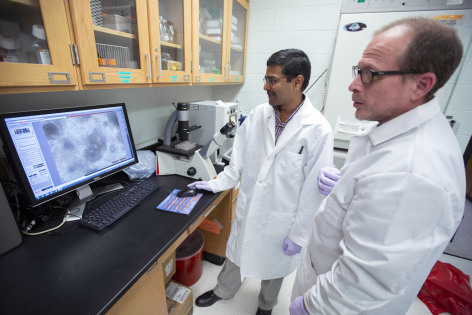
From left are Al Jergens, Jonathan Mochel and Karin Allenspach-Jorn of the ISU College of Veterinary Medicine. The researchers are part of a collaborative research agreement with the FDA that aims to make drug development more efficient and safer. Photo by Christopher Gannon. Larger image.
AMES, Iowa – Developing new drugs to fight life-threatening illnesses can take decades and billions of dollars, but researchers at Iowa State University’s College of Veterinary Medicine hope their new project can introduce greater efficiency to the process while improving safety and effectiveness of new treatments.
The researchers recently entered into a five-year research collaborative agreement with the U.S. Food and Drug Administration to develop an in vitro model, or an experimental model based on canine stem cells. This model will allow scientists to explore potential barriers to the oral absorption of therapeutic drugs without requiring the testing of live animals in a laboratory stetting.
Dana Borcherding, an assistant scientist in biomedical sciences, said this innovative, three-dimensional model, or ‘mini-gut,’ forms from a cluster of cells that mimics the tissues of a canine intestine. Borcherding said the project will improve the ability to predict variability in drug absorption likely to occur across human and animal patient populations. The project also could alert scientists of potential interactions – between drugs or between drugs and supplements – within the gastrointestinal tract that can influence drug absorption or intestinal drug metabolism. The information derived from this new model will be invaluable for developing oral formulations that have a greater likelihood of achieving desirable therapeutic effects, said Jon Mochel, an associate professor of biomedical sciences and lead principal investigator of the agreement with the FDA.
This research will study how factors such as body size, breed and health status can change canine intestinal drug absorption, Mochel said. Equally important, these results will identify how chronic intestinal inflammation can affect drug permeability and gut metabolism. Such information will support therapeutic decisions by veterinary practitioners, he said
All of the benefits associated with this in vitro system can be used to guide drug sponsors on the rate and extent of drug product dissolution in the gut. This information will allow sponsors to make better decisions on product formulation and identify reasons for variability in clinical trial outcomes or potential negative post-marketing experiences.
The ISU team views the current research as a step toward a far-reaching technology that will have a spectrum of potential therapeutic applications. The researchers intend to use this in vitro model to further improve the ability to predict drug efficacy and safety.
Developing new drugs to treat humans often starts with testing in rodents. From there, it can take upwards of 15 years and millions of dollars spent on pharmaceutical testing. And the vast majority of drugs tested in rodents – more than 90 percent – never make it to market, Mochel said.
“Right now, drug development is an inefficient and expensive process,” he said.
The ISU project aims to improve those odds by identifying molecules that could be useful as therapies to treat a range of diseases that affect both humans and dogs, such as colorectal cancer, Crohn’s Disease and Alzheimer’s Disease.
Promising therapeutic candidates identified by the in vitro model could then advance to clinical trials in dogs and cats, said Karin Allenspach-Jorn, a professor of veterinary clinical sciences. Pet owners with diseased dogs and cats will volunteer their animals for the trial therapies. Allenspach-Jorn said many of those trial subjects would come from the pool of patients that receive treatment at the Lloyd Veterinary Medical Center at Iowa State. Treatments that show promise during the trials could lead to new therapies both in veterinary and human medicine. Moreover, because dogs experience many of the same diseases humans suffer, the canine model can lead to more valuable data for pharmaceutical researchers than traditional in vitro and rodent models, she said.
Mochel said many of the untested compounds for use in animal health represent a “black box,” because it can take years of testing to find the best method of delivery, dosage guidelines or how often a drug should be administered to achieve optimal results. The combination of the research team’s in vitro model with clinical trials in dogs and cats and emerging computer-based technologies could help to answer those questions faster, he said.
“We want to open up that black box so we can better understand how drugs are being absorbed and work,” Mochel said. “Clearly, realization of this goal would have tremendous benefits both for our pets and for the human patient.”
